#Kyoto ware
Text
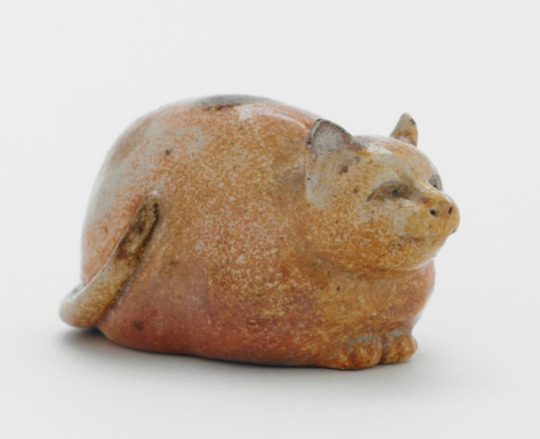
Love this glorious Edo or Meiji era plumpling from Japan. Source.
2K notes
·
View notes
Photo

Tea Bowl, Chrysanthemum design in overglaze enamel ceramics / Kyoto ware / Edo period, 17th century.
https://colbase.nich.go.jp/collection_items/tnm/G-985?locale=en
37 notes
·
View notes
Text
submitted my application to study in Kyoto next year ^u^
#there is a course i am particularly excited for where our class visits the studios of local Kyoto artisans#with demonstrations of crafts such as bamboo bows and screens ' ceramic ware ' yuzen dyeing ' lacquer gathering ' and many more !#✧
1 note
·
View note
Photo
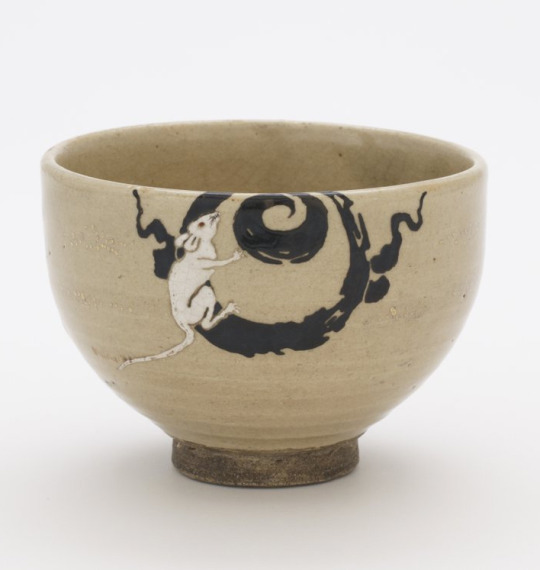
Kyoto ware tea bowl for the New Year, with three impressed seals reading “Shuhei”, by Ogata Shuhei, 19th century
159 notes
·
View notes
Text
Hypnosis Mic Shuffle Team, Vol. 3 (Part 2) (Cont.)
7 Wonders of HypMic
Akihisa "Azrael" Mashiro
Maki "Professor Z-3" Umemoto
Shuu "Men-H" Edogawa
Rintaro "Ignis" Himura
Yoichi "Jekyll" Shujo
Ren "Vox" Nakashima
Kaiji "Jinx" Sano
We Do This (24/7)
youtube
Ghost Squad
Itsuki “Tsuki” Kamiko
Lyall "Corvus" Shiba
Lana "Facade" Alarie
Kanade “Spooky” Alarie
Criss “Paradox” Hiromi
Insane Party
youtube
Influx
Mine "E.R.O.S." Mizushima
Hana "Zanni" Izanami
Mitsuru "Odette" Tenjo
Umi "Doll.Me" Kobayashi
Kaori "WareD" Katou
Kanade "Spooky" Alarie
Throbbing in Our Hearts
youtube
Princess Ego
Ririko "2cute" Akihara
Miyazaki "FASHIONISTA" Aimi
Katsumi "Espada" Kenzaki
Ruling Isn't Easy
youtube
Petite Syndrome
Kanra "D. Vil" Akemi
Yorii "Sireen" Sakuma
Do I Like You? (...Or Not?)
youtube
The Gameaholics
Nikki "1-Up" Yoshie
Makina "Screen Shot" Setsukura
Life is Just a Video Game (...With Fewer Lives)
youtube
Stubborn Paradise
Ren "Vox" Nakashima
Yorii "Sireen" Sakuma
Aiko "Overdrive" Mayeda
Stubborn Paradise
youtube
Masa & His Disciples
Masa "The Father" Judice
Asato “AR Master” Rikiya
Yano “Y-STARR” Ietsuna
Come Into Our Light (The Sermon)
youtube
The Ones Left Behind
Ren "Vox" Nakashima
Yorii "Sireen" Sakuma
Takumi "GUTS" Wakaba
Saji "Street Dog" Buranka
Aoba "Guinevere" Yamamura
Where'd You Go?
youtube
Caliber of Men
Lyall "Corvus" Shiba
Natsume "Wanderer" Kurome
Ace "MC Patriot" Douglas
Elliot "MC Nanashi" Shimizu
Yeong "9-Dan" Hajoon
Fall Under Our Spell, Tonight
youtube
@katsushika-division @suginami-division @sapporo-division @kobedivision @kyoto-division @niigata-division @akihabaradivision @akihabara-division03 @odaibadivision @tokyo-division @nerima-division @nakanodivision @urayasu-division @edogawa-division @setagaya-division @takatsuki-division @ginza-division @toyama-division @sendaidivision @megurodivision @kumamoto-division @okinawa-division
#hypnosis microphone#hypmic oc#hypnosis mic oc#hypnosis mic#hypmic#shuffle album#shuffle team#collab event#Youtube#hypnosis mic shuffle team 2023
24 notes
·
View notes
Text
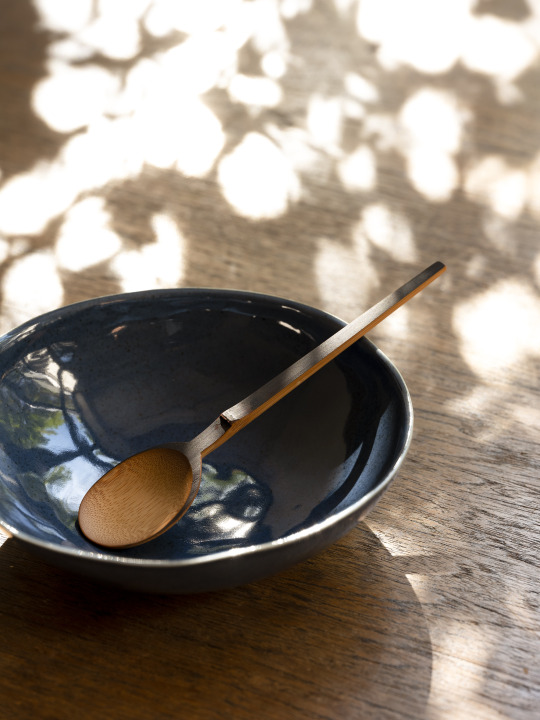
Exhibition of bamboo ware by Kazuho Shimomoto at Kyoto store.
Babaghuri Kyoto
2/17(Sat)〜2/25(Sun)
11:00-19:00
12 notes
·
View notes
Text

“Three-legged drinking vessel with handle. Black high-fired ware. China. Fifteenth to tenth century B.c. Height, 19.3 cm. Excavaled at archaeological site on Liaotung Peninsula. Department of Humanities, Kyoto University.”
From: “ the art of Japanese Ceramics” by Mikami, Tsugio; 1972.
12 notes
·
View notes
Text
Adventures with Tenmoku
Tenmoku or Tenmokuyu or even Temoku, is a general term used for a glossy, deep brown iron glaze in ceramics and pottery.

I was introduced to Tenmoku from my early days working with clay, over two years now. Initially I didn't really like it, finding it sometimes too dark, but not quite black, either. The endearing power of the glaze, however, is that it has a depth and range of browns. Depending on how it is applied, it varies from dark brown, to warmer brown, to translucent even when applied thinly. I have used it on many occasions, especially for my coil pots.
Below you can see the results when I used it for my large coil pot, Rosey, (seen below) combined with a commercial raspberry glaze (Mayco). The result was a range of dark purples and browns, that give depth to the surface of the pot. I particularly like the glossy finish as this reflects light and adds an element of sophistication to my work.
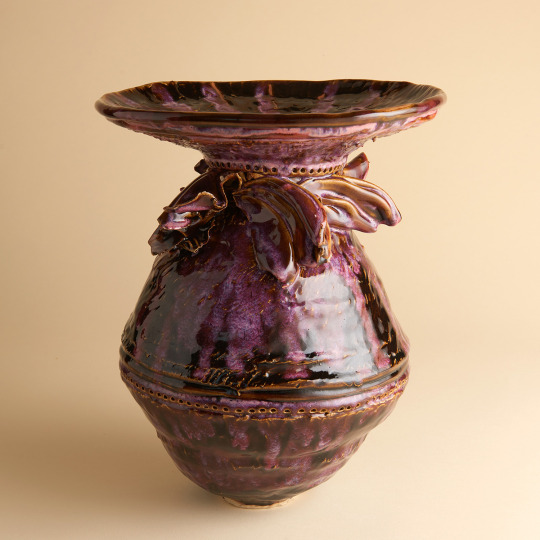
The history: Tenmoku glazes originate from Japan, where they have a very long history. Popularised by tea bowls, initially, Tenmoku referred to both the shape of the tea bowl and the dark, glossy glaze that covered these bowls.
Introduced by Japanese monks and priests that came back from China, after visiting the sacred Tianmu Mountain, in the Heian Period (794-1185). At this time, tea drinking was reserved for the rich and the Emperor. With the rise of the popularity of tea drinking, however, by the middle ages (Kamakura and Muromachi periods) so too, the popularity of the tenmoku teabowls spread amongst the larger population.
The example below is typical example of the tea bowl, known for its distinct dark brown colour. This one is from the Kyoto National Museum,
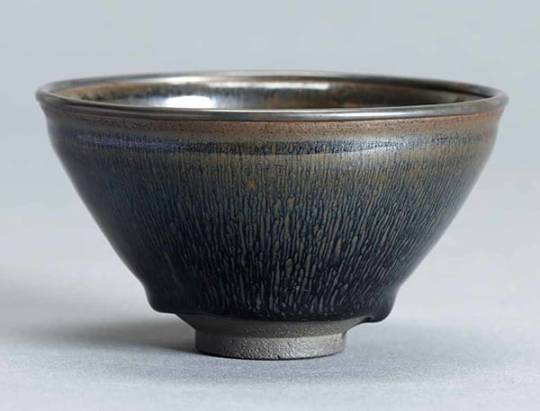
In England, it was introduced in the 1950's by Bernard Leach and the Leach Pottery in St.Ives, Cornwall, after the visit of Japanese master potter Shoji Hamada, at St. Ives. It has been widely used since in function ware, especially coffee mugs, jugs and other tableware.
Below, you can see two examples of Tenmoku, the one on the left, is the Tenmoku tea bowl, by master Shoji Hamada, in the collection of Tate Museum, whilst the one on the left, is currently on display at the exhibition, The Art of the Potter: Ceramics and Sculpture 1930's to now, at the Hepworth, Wakefield and belongs to the potter David Leach, of the Leach family.

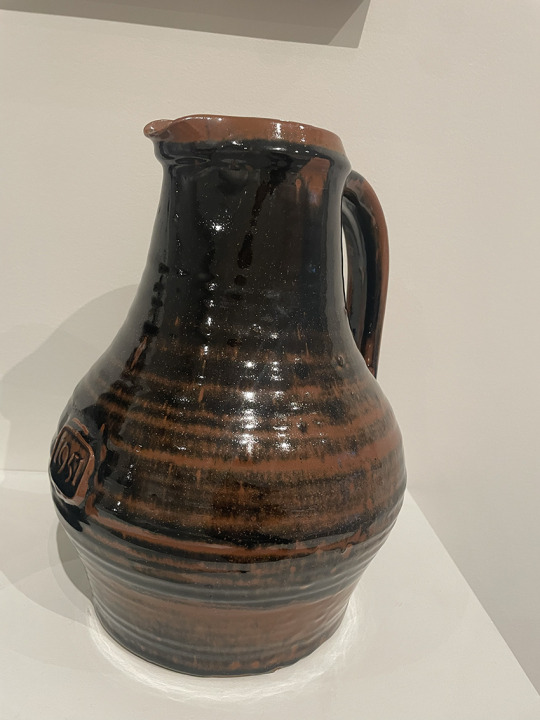
It has been criticised often for being old fashioned, however what draws me to this glaze its history and notoriety as well as the fact that it has withstood the test of time and remains, remarkably, a staple glaze for many pottery studios today.
During my residency at Rochester Square Arts, over the summer and autumn this year, I sought to make my own batch of Tenmoku.
Not knowing what I would get myself into, I began my adventures with iron oxides. Having only done a very short course in making my own custom glazes, equipped with raw materials like iron oxide, manganese oxide and fluxes, like nepheline syenite, cornish stone and potash feldspar, I began my very first tests.
The first recipe I tested was of the iconic Bernard Leach tenmoku. This did give some interesting results but I was disappointed, as the application of the glaze was uneven in areas and didn't yield the deep, rich browns I was hoping for.

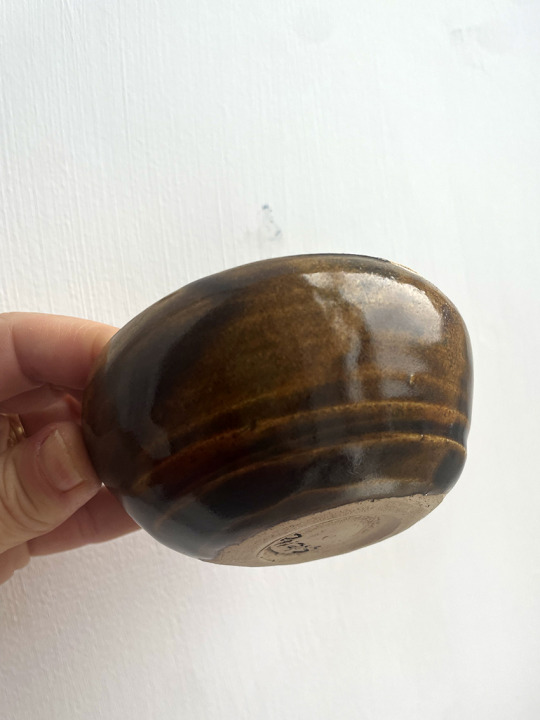
The second recipe I tried, was from the contemporary Florian Gadsby, the ceramicist based in North London. It comes complete with a YouTube video, for fool-proof testing. 😀
I was drawn to the simple three ingredients of this recipe: definitely a lot of Cornish Stone (85%) Whiting (15%) and quite a bit of the Red Iron Oxide (16%). This one, finally, gave me the sleek, mirror-like surface of the finish I was hoping for. However, for my taste, the 16% red iron oxide is too much. Below, you can see my test tile results of this on B17 stoneware clay and Porcelain.
I found this one way too dark, so I made another test batch, with a recipe from The Glaze Book, by Stephen Murphitt.
FInally, as a last tester I tried my own former teacher's Tenmoku, Chris Crawford, at Sunken Studios.
I am not sure I got the mix quite right here as there are some delicate balances, and this one contains a lot more ingredients than the above. In the classic Bernard Leach, Potash Feldspar is used as the flux, whilst here I do like the substitution of Potash with Nepheline Syenite.
The verdict? I really like the glossy, mirror like finish that the Gadsby's Cornish Stone recipe gives. It also avoid the pin-holing that can occur with Tenmoku recipes.
I think I will settle for this one, with the Iron Oxide at 12% instead of 16%.



Further links and reading:
#ceramics#glazing#contemporary art#fine art#women in art#custom made#kyoto#japan#bernardleach#tenmoku#artscouncilfunding#dycpfunding#arthousewakefield
2 notes
·
View notes
Note
My train of thought at work today while mixing paint to the color called 'Kyoto Pearl', led me to imagining Hakuno as a pearl diver who sells her wares to Gilgamesh's store. It was somehow adorable.
This sounds precious.
2 notes
·
View notes
Text
incomplete list of all the fun i had in japan on my holiday
the bus trip from narita airport to shinjuku, the scenery was so gorgeous, i got to see my first cherry blossoms and first part of the city
sorakara-chan the mascot at the skytower, they also have nice lemonade there, and it was fun to walk on the floor windows too
the shogun's gardens are so cool you can hear the martial artists train - the imperial s garden was very nice as well, the azelias were in full bloom
karaoke with three of the others on the tour with me was tonnes of fun as well
also at karaoke i was the only one who could speak Japanese so I was ordering drinks for the other girls and had A VERY INTENSE “conversation” with the older waiter who spoke no English so it was very unintentionally funny experience to try and convey that i wanted two bottles (nipikki) of sake but I said nisai instead (so 2 years). also the Spanish-Irish chica said the sake that they/we ordered (I was soft drinks only) was the best she ever had
i loved having chanko for lunch and the similar ones as well (though the himeji oden set wasn't my favourite...)
asakusa shrine was so busy but i liked the balancing of the shinto and buddist faiths
meiji shrine was beautiful, the trees there are gorgeous and heartfelt, we also saw a wedding procession!!! the bride and groom looked stunning in their traditional ware
the cruise night was good too
IKEBUKURO MY BELOVED. the area was nerd heaven. i saw fellow yumejoshi god bless, bought a giant smoliv plush at the pokemon centre, and stuff like that yeah
the inari shrine/thousand torii gate shrine is definitely on my come back to list since there wasn't enough time to do the full summit
shoutout to the hotel we stayed at in mishima city, easily my favourite hotel, them soft beds went a long way, not to mention we could see mt fuji at breakfast
(for me personally that hotel was even outclassing the five star hotel we stayed at which is a highlight and also was home to foreign dignitaries and celebrities :o
mt fuji. just. mt fuji in general. absolutely gorgeous, breathtaking, stunning, thank god we did not climb it as i was coming down with a cold the day we were meant to but mt fuji meanwhile was coming down with an avalanche risk so only looking for afar
oshina hokkai is gorgeous, i would love to come back there at peak with more time to wander
i also loved the little historical village, i can't remember its name rn but i loved seeing the different girls day and children's day displays, the tanuki statues and the scarecrows, the rubber duckies in the various streams, too
the various tanuki statues i saw all over the place deserve their own bullet point tbh
making soba was fun but i didn’t actually enjoy eating the soba, i wanted to try yakisoba though
i'm kinda blanking at this 3/4 mark because all i really remember is the bullet train journeys which are cool i guess but i'm not a train nerd like my dad lol, it just felt like taking a normal train to me
the osaka okonomiyaki lunch was my favourite lunch, probably
i loved the kyoto hotel we had dinner at too, they gave me extra on desserts. and also bread. carbs yippie
ooh the italian cafe we had lunch at in shibuya was also really good actually so i'll mention it here too
kiyomizu shrine was my Absolute Favourite Highlight, it was gorgeous and had so much history behind it, the shops are good too, i hope to visit it again one day, would especially love to visit in autumn/maple leaf season. also I got to drink from the fountains of long life, beauty, and wisdom which is really significant because normally that's impossible to do due to queues/demands. and also all the buddha with their bibs is adorable.
also at kiyomizu, one of my fellow tour goers did something so unintentionally hilarious, i want to add it. this guy was very cautious, always masked up and sanitising so we were all very surprised to go watch him fill up a ladle at the fountain... only for him to immediately dump it into the basin below instead of drinking it like I and a couple others did
miyajima island is amazing!! i definitely want to go back there in autumn one day. i had momiji manju with custard filling and it was so delicious. i visted the art museum there and the attendant on the second level gave me an Exclusive Special Experience™️ because I managed to convey that whilst I couldn't speak Japanese on account of my sore throat, i can understand it so they gave me a big art spiel and then turned off the lights so i could see this one silk screen literally glow in the dark like the moon
the himeji gardens were my favourite set of gardens!! i saw a cat and lots of pretty ponds
threw coins in okiku well at the himeji castle (well's haunted) and the architecture of himeji whilst a nightmare for a flat footer like me is awful but its still very beautiful i'm probably missing some stuff but i've had a big, big week and a bit in japan
4 notes
·
View notes
Photo

Elephant Censor
A glazed Kyoto ware model of an elephant, most possibly used as an incense burner. (One leg reattached.)
Japan, 17th century
15.5 x 8 cms
Brandt Asian Art
142 notes
·
View notes
Photo

New arrivals! Vintage Kiyomizu ware salad bowl by Unraku Saito from Kyoto. Dynamic colorful flower painting on the side❤️ The design includes holes on the side, not suitable for liquid. Now available on our online store and at our Parisian boutique. #maisonsatoparis #saladbowl #japanesetableware #japaneseceramics #kiyomizuware #vaissellejaponaise #boljaponais #菓子鉢 (à Paris, France) https://www.instagram.com/p/CpNrVYAp_gz/?igshid=NGJjMDIxMWI=
#maisonsatoparis#saladbowl#japanesetableware#japaneseceramics#kiyomizuware#vaissellejaponaise#boljaponais#菓子鉢
2 notes
·
View notes
Photo

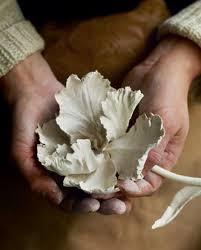
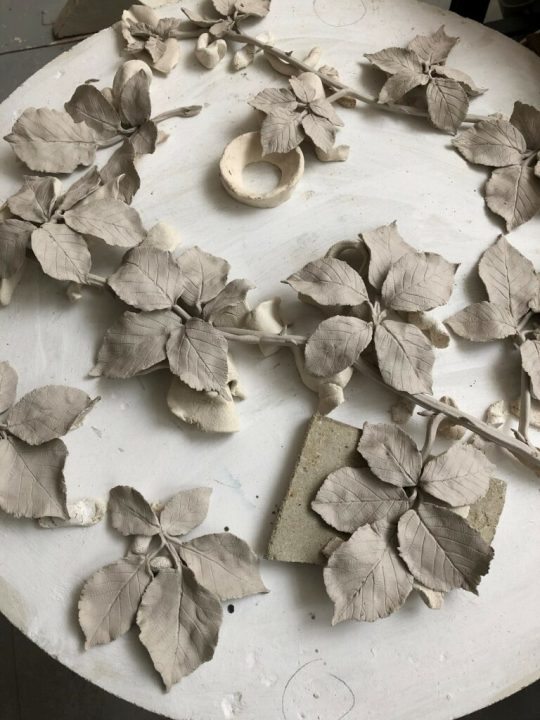







Kaori Tatebayashi: "I was born in Arita in Japan, a little village renowned for Arita porcelain, which in Europe is known as Old Imari. My grandfather was an Arita-ware merchant and took orders from hotels and restaurants from all over Japan. The scene of my family gathering together to pack tableware commissioned from various potteries in the village in navy blue paper with our family company logo remain vividly in my memory as a fun event.
Each May, we participated in a pottery festival in Arita. My cousins and I were allowed to sell little porcelain figurines next to adults selling tableware and, when we sold the figurines, we were treated with too many ice creams by visiting relatives. In 2016 Arita celebrated 400 years of porcelain production. Although I don’t work in porcelain, ceramic is definitely in my blood.
"Kaori Tatebayashi is a Japanese ceramicist living and working in London. She comes from a family of ceramics traders, and was surrounded by traditional Japanese ceramics from an early age. After gaining an MA in Ceramics from Kyoto City University of Art, in 1995 she came to London on an exchange programme to study at the Royal College of Art.
https://digdelve.com/kaori-tatebayashi/
10 notes
·
View notes
Text
IMAGEN Y PALABRA: BAMBUSAL DE ARASHIYAMA, Autoría, Aetheria
IMAGEN Y PALABRA: BAMBUSAL DE ARASHIYAMA, Autoría, Aetheria
@AetheriaTravels
Imagen y Palabra: Bambusal de Arashiyama
“En las montañas vacías
Las hojas de bambú
Susurran al viento.
Y pienso en ella,
que no está aquí”
“Sasa no ha wa
Miyama mo saya ni
Sayagedomo
Ware wo imo omo
Wakare kinureba”
Kakinomoto No Hitomaro
La imagen:
Este bosque de bambú se encuentra en la localidad de Arashiyama, al oeste de la ciudad japonesa de Kyoto. A ambos lados de un estrecho camino, los…
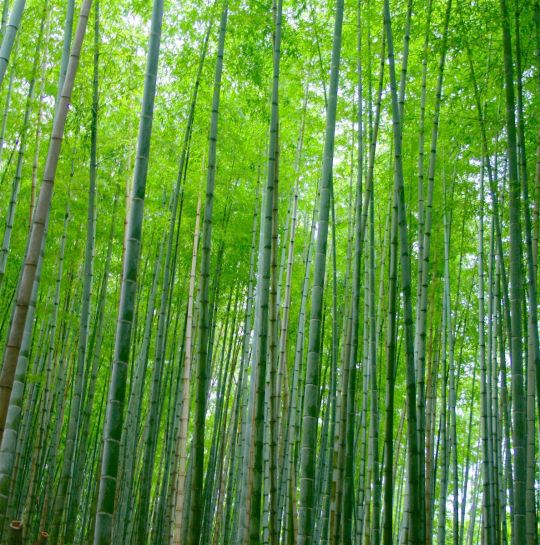
View On WordPress
#Aetheria#Bambusal de Arashiyama#Imagen y Palabra#Kakinomoto No Hitomaro#Las hojas de bambú susurran al viento#Poesía japonesa#Tanka#Viajar ver conocer
0 notes
Text
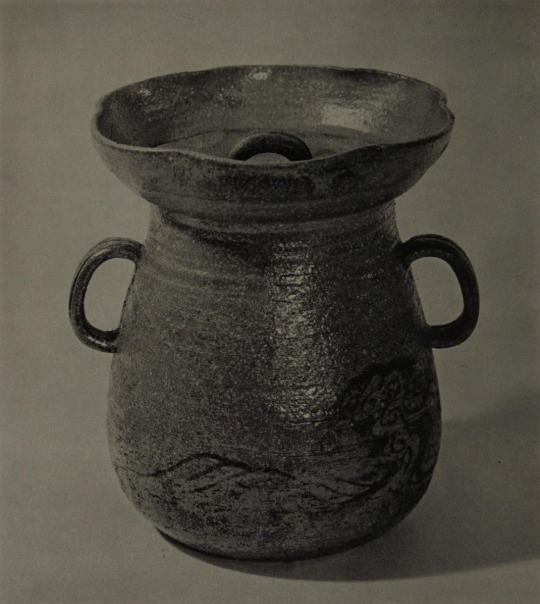
“Awataguchi-ware pouch-shaped water jar with an underglaze iron-oxide design of waves. Tekisui Art Museum Ashiya.”
From: “Kyoto ceramics” by Sāto, Masahiko; 1973.
8 notes
·
View notes
